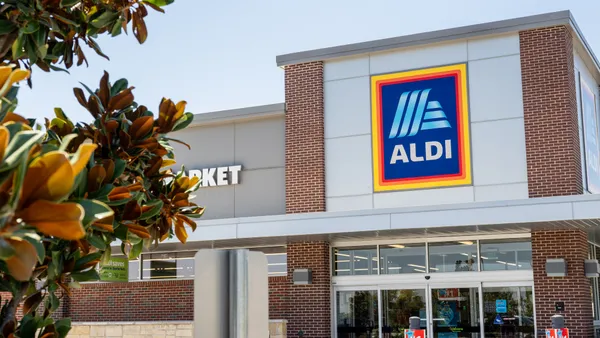Dive Brief:
- Takeoff Technologies announced it will open a robot-powered microsite in Miami this month that will fill online orders for 14 area Sedano’s Supermarkets and also offer on-site pickup for shoppers.
- The site, which Takeoff Technologies is calling “the world’s first robotic supermarket,” uses AI-powered robots to pick and pack up to 60 items in a few minutes. That’s “a fraction of the speed and cost of current manual picking options,” according to the company.
- Takeoff aims to build microsites that are one eighth the size of a conventional supermarket and can service multiple retailers, including grocers and convenience stores. The company says it’s in talks with five additional retail chains and plans to open several sites next year. It also named former Ahold USA CEO James McCann as an investor and advisory board member.
Dive Insight:
The industry has seen two major grocers invest in automated fulfillment recently: Kroger in a big way with Ocado; and Walmart in a one-store test with Alert Innovations. The initiatives are different in their scale — Ocado builds massive off-site warehouses whereas Walmart’s new facility is attached to its Salem, New Hampshire store — but both involve robots very efficiently assembling online orders.
This sort of technology is highly sophisticated and very expensive — but it isn’t just for the big guys. Just as Instacart and Shipt brought many grocers online, technology firms like Takeoff and Commonsense Robotics aim to partner with retailers to bring automated fulfillment to their stores.
This comes as a response to online grocery’s projected growth and its tricky economics. Most stores rely on workers to pick and pack their online orders, either from the retail floor, or from a backroom. But robots can work faster and cheaper over the long run, and thus can bring down the cost of online fulfillment as it scales. Automated systems like the ones Takeoff and Alert Innovations offer don’t eliminate human workers entirely — employees are still needed to tackle the finer points of assembling and delivering orders — but they do address repeatable processes that can be streamlined.
Speed is a big selling point for the microsite model. Unlike Ocado, which builds massive warehouses outside of urban centers, Takeoff and CommonSense’s microsites can fit inside cities, thus bringing grocery fulfillment closer to stores and to customers.
With online grocery projected to become a $100 billion business in the next few years, automated fulfillment could help grocers scale up and compete with deep-pocked competitors like Amazon and Walmart. But there’s a lot left to prove — most notably, if the technology will be worth the upfront cost, and if it can meet and even accelerate consumer demand.
Meanwhile, it will be interesting to see how e-commerce leaders Instacart and Shipt address this competitive threat. Both companies have forged partnerships with leading retailers and will look to strengthen those relationships in the months and years ahead. Will automation become part of that equation?









